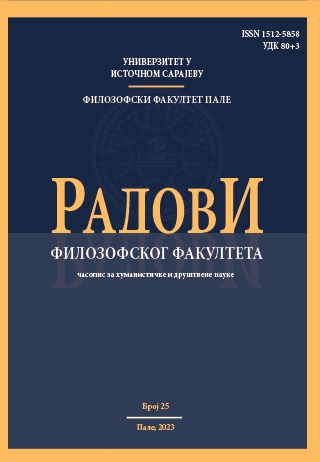КЊИГЕ БОГДАНА Р. МИЛАНОВИЋА КРАЈИШНИКА ИЗ ПЕРСПЕКТИВЕ ТИПОГРАФСКО-ИЗДАВАЧКЕ ДЈЕЛАТНОСТИ
THE BOOKS OF R. MILANOVIĆ KRAJIŠNIK IN THE CONTEXT OF TYPOGRAPHY AND PUBLISHING
Author(s): Radoslavka R. SudarušićSubject(s): Library and Information Science, Library operations and management, Serbian Literature
Published by: Универзитет у Источном Сарајеву, Филозофски факултет Пале
Keywords: Bogdan R. Milanović Krajišnik; printed book; poetry collection; typography; publishing; bookselling;
Summary/Abstract: The merchant and poet Bogdan R. Milanović Krajišnik (Lika, 1877 – Ulcinj, 1902) lived and worked during the Austro-Hungarian rule in Bosnia and Herzegovina. He published two collections of poems: "Prvi cvijetak. Pjesme za odrasliju srpsku mladež. Knjiga prva (Velika Kikinda, Štamparija Srpske knjižarnice, 1895) and "Krajiškinje. Pjesme. Knjiga druga" (Zagreb, Srpska štamparija, 1899). He contributed to well-known literary magazines of his time (Golub, Neven, Spomenak, Zorica, Bosanska vila, Zora, Bosansko-hercegovački istočnik, Srpski magazin, Luča, etc.). He primarily wrote patriotic poetry and collected and published folk creations while sending contributions to political newspapers. He supported cultural and educational institutions and often helped the poor. He was elected as the first honorary member of the Serbian Orthodox Singing Society "Milutinović" in Bosanska Krupa. In collaboration with teacher Katica Krajic from Velika Kikinda, he founded the Benevolent Cooperative "Srpkinja Petrovčanka". The research focus of this article is the books of Bogdan R. Milanović, viewed from the perspective of typography and publishing. The article is structured into two thematic sections: "The Poet and His Work" and "Typographical Design of Bogdan R. Milanović's Poetry Collections". In addition to a brief overview of the biography and literary work of Bogdan R. Milanović, special attention is dedicated to the graphic design of the books Prvi cvijetak and Krajiškinje. These books are viewed as objects of the typographical industry. Alongside this examination, the fundamental characteristics of the printing and publishing industry at the end of the 19th century are highlighted. This paper assesses the contribution of publishers to the final appearance of Milanović's poetry collections. In the realm of graphic design, a book emerges as a dedicated work of art. The beauty of its design serves to attract the attention of buyers. In this regard, the publisher, quite deliberately, engages specialized artists and commissions ornaments, following the requirements of the current artistic epoch. It is the publisher who expects to profit from this product and skilfully employs visual elements in their publications. Using the examples of the mentioned poetry collections, we examine both the artistic and economic-commercial aspects of a book
Journal: Радови Филозофског факултета (часопис за хуманистичке и друштвене науке)
- Issue Year: 2023
- Issue No: 25
- Page Range: 191-212
- Page Count: 22
- Language: Serbian

